BUS4001 - Understanding the Business Environment: Sainsbury's
VerifiedAdded on 2023/06/18
|13
|4030
|253
Report
AI Summary
This report provides a comprehensive analysis of Sainsbury's business environment, utilizing frameworks such as PESTLE and Porter's Five Forces to assess the political, economic, social, technological, environmental, and legal factors impacting the company. It examines the competitive structure of the UK supermarket industry, identifying it as an oligopoly, and delves into stakeholder theory, analyzing the various stakeholders and their interests related to Sainsbury's. The report also discusses the national economic system under which the United Kingdom operates, highlighting the advantages and disadvantages, and explores the macroeconomic objectives set by the government that affect the organization. This detailed analysis offers a holistic view of Sainsbury's operational context and strategic considerations.
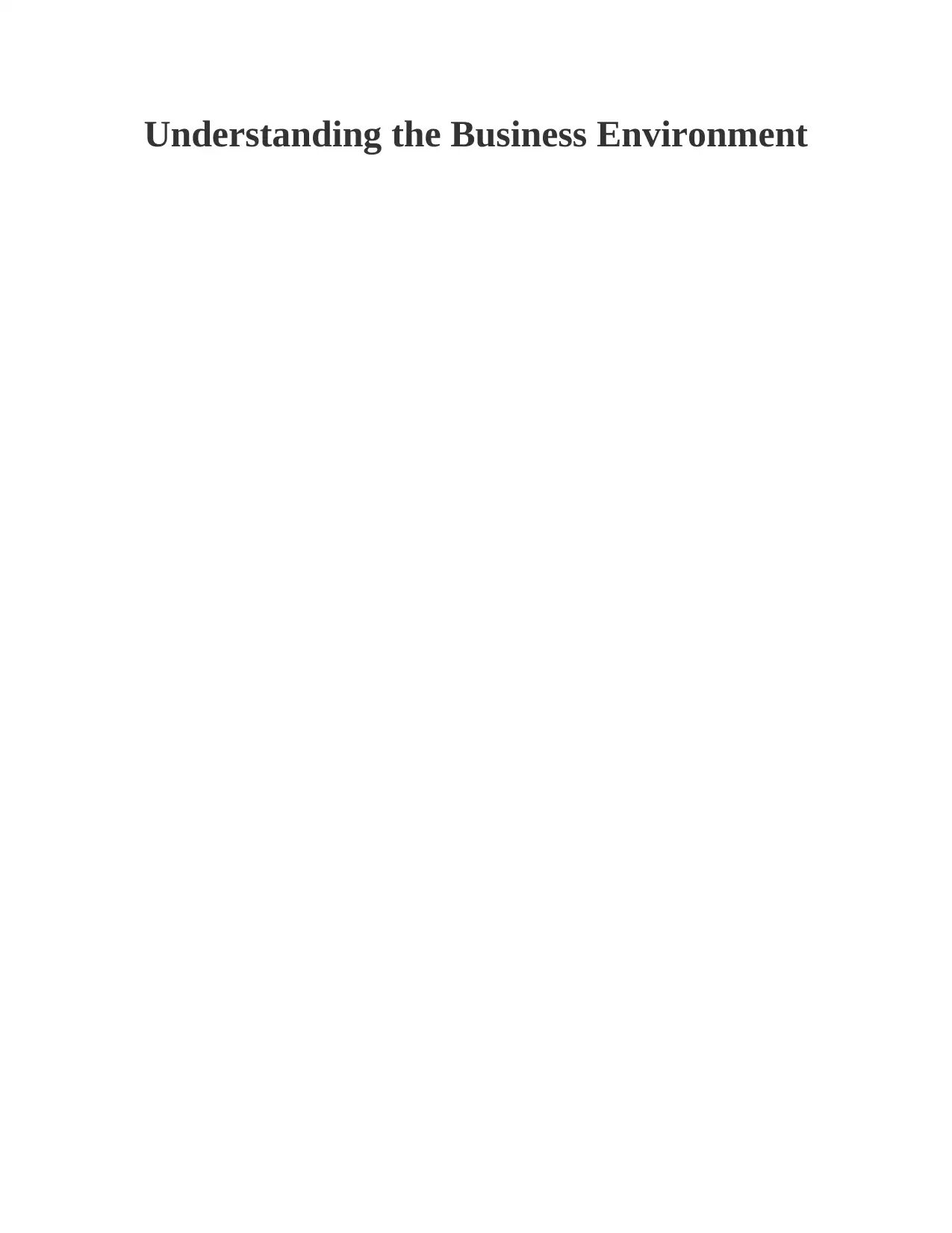
Understanding the Business Environment
Paraphrase This Document
Need a fresh take? Get an instant paraphrase of this document with our AI Paraphraser
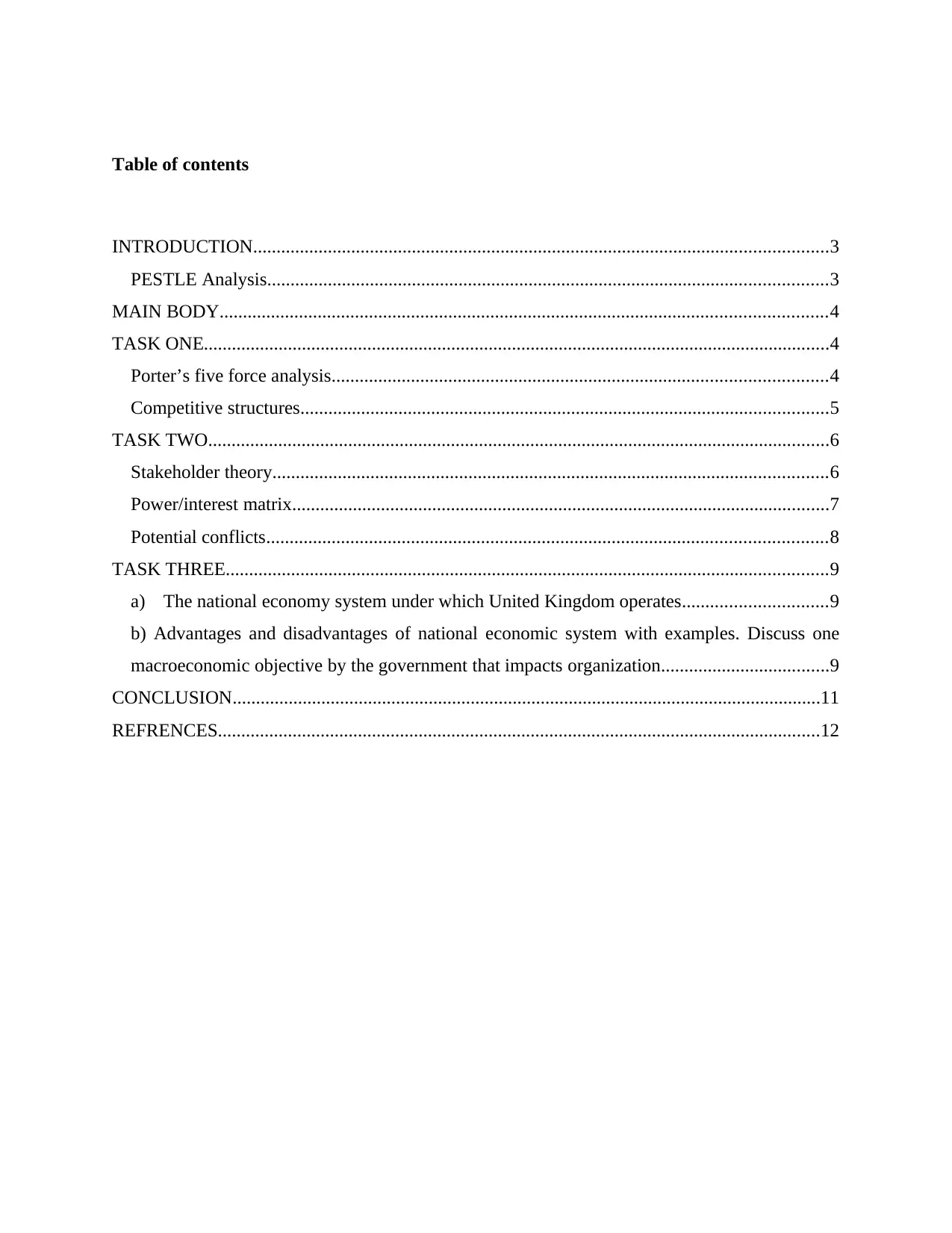
Table of contents
INTRODUCTION...........................................................................................................................3
PESTLE Analysis........................................................................................................................3
MAIN BODY..................................................................................................................................4
TASK ONE......................................................................................................................................4
Porter’s five force analysis..........................................................................................................4
Competitive structures.................................................................................................................5
TASK TWO.....................................................................................................................................6
Stakeholder theory.......................................................................................................................6
Power/interest matrix...................................................................................................................7
Potential conflicts........................................................................................................................8
TASK THREE.................................................................................................................................9
a) The national economy system under which United Kingdom operates...............................9
b) Advantages and disadvantages of national economic system with examples. Discuss one
macroeconomic objective by the government that impacts organization....................................9
CONCLUSION..............................................................................................................................11
REFRENCES.................................................................................................................................12
INTRODUCTION...........................................................................................................................3
PESTLE Analysis........................................................................................................................3
MAIN BODY..................................................................................................................................4
TASK ONE......................................................................................................................................4
Porter’s five force analysis..........................................................................................................4
Competitive structures.................................................................................................................5
TASK TWO.....................................................................................................................................6
Stakeholder theory.......................................................................................................................6
Power/interest matrix...................................................................................................................7
Potential conflicts........................................................................................................................8
TASK THREE.................................................................................................................................9
a) The national economy system under which United Kingdom operates...............................9
b) Advantages and disadvantages of national economic system with examples. Discuss one
macroeconomic objective by the government that impacts organization....................................9
CONCLUSION..............................................................................................................................11
REFRENCES.................................................................................................................................12
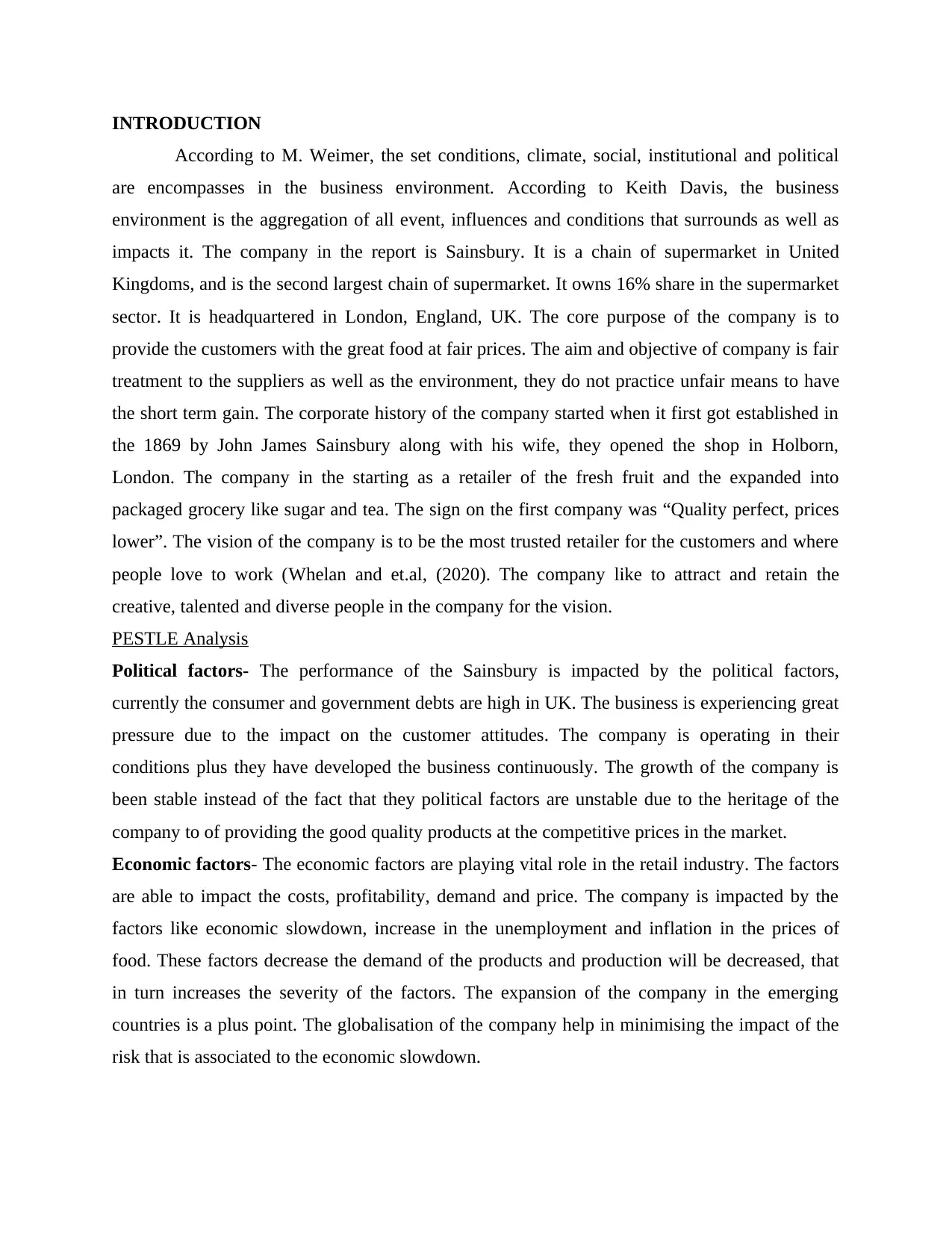
INTRODUCTION
According to M. Weimer, the set conditions, climate, social, institutional and political
are encompasses in the business environment. According to Keith Davis, the business
environment is the aggregation of all event, influences and conditions that surrounds as well as
impacts it. The company in the report is Sainsbury. It is a chain of supermarket in United
Kingdoms, and is the second largest chain of supermarket. It owns 16% share in the supermarket
sector. It is headquartered in London, England, UK. The core purpose of the company is to
provide the customers with the great food at fair prices. The aim and objective of company is fair
treatment to the suppliers as well as the environment, they do not practice unfair means to have
the short term gain. The corporate history of the company started when it first got established in
the 1869 by John James Sainsbury along with his wife, they opened the shop in Holborn,
London. The company in the starting as a retailer of the fresh fruit and the expanded into
packaged grocery like sugar and tea. The sign on the first company was “Quality perfect, prices
lower”. The vision of the company is to be the most trusted retailer for the customers and where
people love to work (Whelan and et.al, (2020). The company like to attract and retain the
creative, talented and diverse people in the company for the vision.
PESTLE Analysis
Political factors- The performance of the Sainsbury is impacted by the political factors,
currently the consumer and government debts are high in UK. The business is experiencing great
pressure due to the impact on the customer attitudes. The company is operating in their
conditions plus they have developed the business continuously. The growth of the company is
been stable instead of the fact that they political factors are unstable due to the heritage of the
company to of providing the good quality products at the competitive prices in the market.
Economic factors- The economic factors are playing vital role in the retail industry. The factors
are able to impact the costs, profitability, demand and price. The company is impacted by the
factors like economic slowdown, increase in the unemployment and inflation in the prices of
food. These factors decrease the demand of the products and production will be decreased, that
in turn increases the severity of the factors. The expansion of the company in the emerging
countries is a plus point. The globalisation of the company help in minimising the impact of the
risk that is associated to the economic slowdown.
According to M. Weimer, the set conditions, climate, social, institutional and political
are encompasses in the business environment. According to Keith Davis, the business
environment is the aggregation of all event, influences and conditions that surrounds as well as
impacts it. The company in the report is Sainsbury. It is a chain of supermarket in United
Kingdoms, and is the second largest chain of supermarket. It owns 16% share in the supermarket
sector. It is headquartered in London, England, UK. The core purpose of the company is to
provide the customers with the great food at fair prices. The aim and objective of company is fair
treatment to the suppliers as well as the environment, they do not practice unfair means to have
the short term gain. The corporate history of the company started when it first got established in
the 1869 by John James Sainsbury along with his wife, they opened the shop in Holborn,
London. The company in the starting as a retailer of the fresh fruit and the expanded into
packaged grocery like sugar and tea. The sign on the first company was “Quality perfect, prices
lower”. The vision of the company is to be the most trusted retailer for the customers and where
people love to work (Whelan and et.al, (2020). The company like to attract and retain the
creative, talented and diverse people in the company for the vision.
PESTLE Analysis
Political factors- The performance of the Sainsbury is impacted by the political factors,
currently the consumer and government debts are high in UK. The business is experiencing great
pressure due to the impact on the customer attitudes. The company is operating in their
conditions plus they have developed the business continuously. The growth of the company is
been stable instead of the fact that they political factors are unstable due to the heritage of the
company to of providing the good quality products at the competitive prices in the market.
Economic factors- The economic factors are playing vital role in the retail industry. The factors
are able to impact the costs, profitability, demand and price. The company is impacted by the
factors like economic slowdown, increase in the unemployment and inflation in the prices of
food. These factors decrease the demand of the products and production will be decreased, that
in turn increases the severity of the factors. The expansion of the company in the emerging
countries is a plus point. The globalisation of the company help in minimising the impact of the
risk that is associated to the economic slowdown.
⊘ This is a preview!⊘
Do you want full access?
Subscribe today to unlock all pages.

Trusted by 1+ million students worldwide
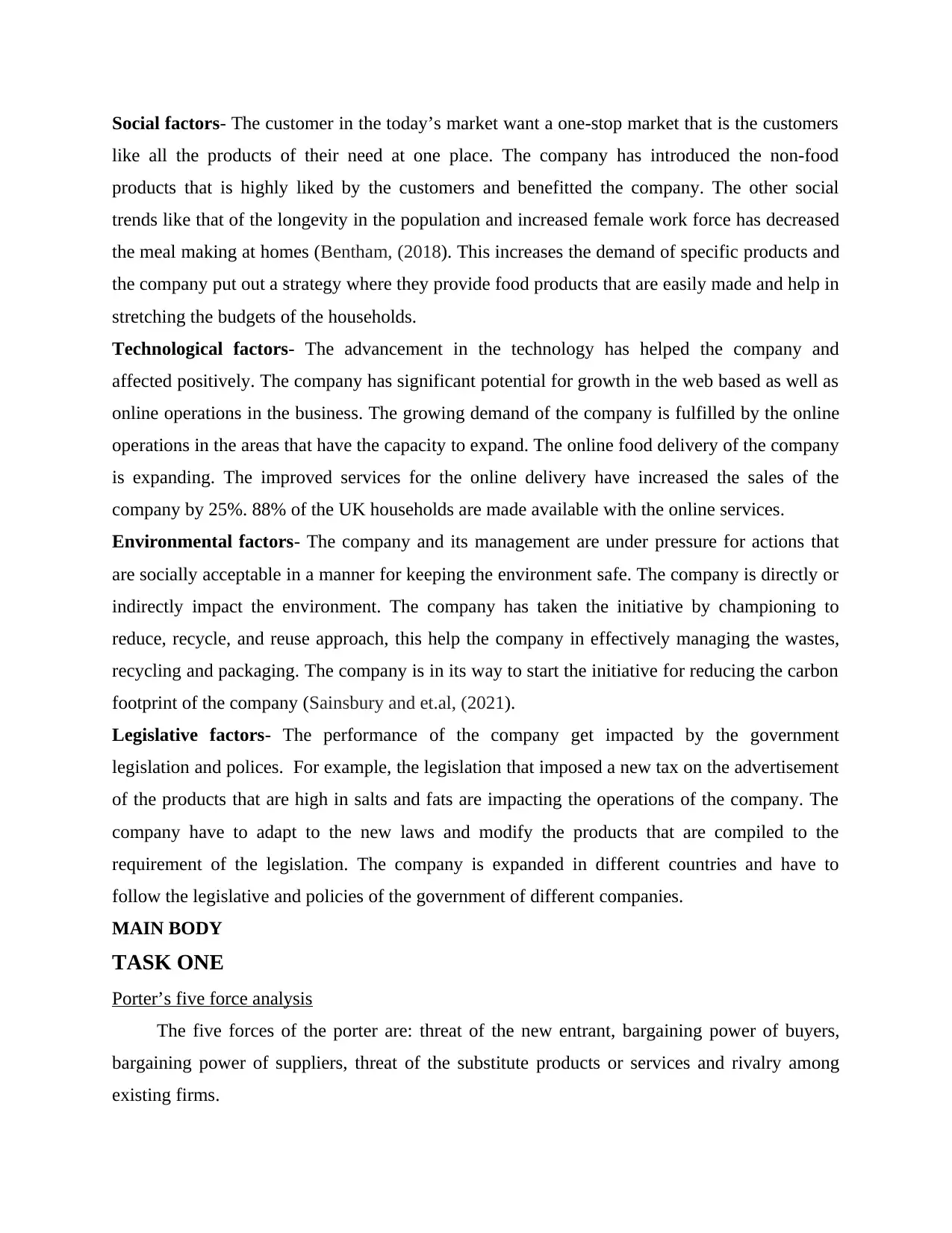
Social factors- The customer in the today’s market want a one-stop market that is the customers
like all the products of their need at one place. The company has introduced the non-food
products that is highly liked by the customers and benefitted the company. The other social
trends like that of the longevity in the population and increased female work force has decreased
the meal making at homes (Bentham, (2018). This increases the demand of specific products and
the company put out a strategy where they provide food products that are easily made and help in
stretching the budgets of the households.
Technological factors- The advancement in the technology has helped the company and
affected positively. The company has significant potential for growth in the web based as well as
online operations in the business. The growing demand of the company is fulfilled by the online
operations in the areas that have the capacity to expand. The online food delivery of the company
is expanding. The improved services for the online delivery have increased the sales of the
company by 25%. 88% of the UK households are made available with the online services.
Environmental factors- The company and its management are under pressure for actions that
are socially acceptable in a manner for keeping the environment safe. The company is directly or
indirectly impact the environment. The company has taken the initiative by championing to
reduce, recycle, and reuse approach, this help the company in effectively managing the wastes,
recycling and packaging. The company is in its way to start the initiative for reducing the carbon
footprint of the company (Sainsbury and et.al, (2021).
Legislative factors- The performance of the company get impacted by the government
legislation and polices. For example, the legislation that imposed a new tax on the advertisement
of the products that are high in salts and fats are impacting the operations of the company. The
company have to adapt to the new laws and modify the products that are compiled to the
requirement of the legislation. The company is expanded in different countries and have to
follow the legislative and policies of the government of different companies.
MAIN BODY
TASK ONE
Porter’s five force analysis
The five forces of the porter are: threat of the new entrant, bargaining power of buyers,
bargaining power of suppliers, threat of the substitute products or services and rivalry among
existing firms.
like all the products of their need at one place. The company has introduced the non-food
products that is highly liked by the customers and benefitted the company. The other social
trends like that of the longevity in the population and increased female work force has decreased
the meal making at homes (Bentham, (2018). This increases the demand of specific products and
the company put out a strategy where they provide food products that are easily made and help in
stretching the budgets of the households.
Technological factors- The advancement in the technology has helped the company and
affected positively. The company has significant potential for growth in the web based as well as
online operations in the business. The growing demand of the company is fulfilled by the online
operations in the areas that have the capacity to expand. The online food delivery of the company
is expanding. The improved services for the online delivery have increased the sales of the
company by 25%. 88% of the UK households are made available with the online services.
Environmental factors- The company and its management are under pressure for actions that
are socially acceptable in a manner for keeping the environment safe. The company is directly or
indirectly impact the environment. The company has taken the initiative by championing to
reduce, recycle, and reuse approach, this help the company in effectively managing the wastes,
recycling and packaging. The company is in its way to start the initiative for reducing the carbon
footprint of the company (Sainsbury and et.al, (2021).
Legislative factors- The performance of the company get impacted by the government
legislation and polices. For example, the legislation that imposed a new tax on the advertisement
of the products that are high in salts and fats are impacting the operations of the company. The
company have to adapt to the new laws and modify the products that are compiled to the
requirement of the legislation. The company is expanded in different countries and have to
follow the legislative and policies of the government of different companies.
MAIN BODY
TASK ONE
Porter’s five force analysis
The five forces of the porter are: threat of the new entrant, bargaining power of buyers,
bargaining power of suppliers, threat of the substitute products or services and rivalry among
existing firms.
Paraphrase This Document
Need a fresh take? Get an instant paraphrase of this document with our AI Paraphraser
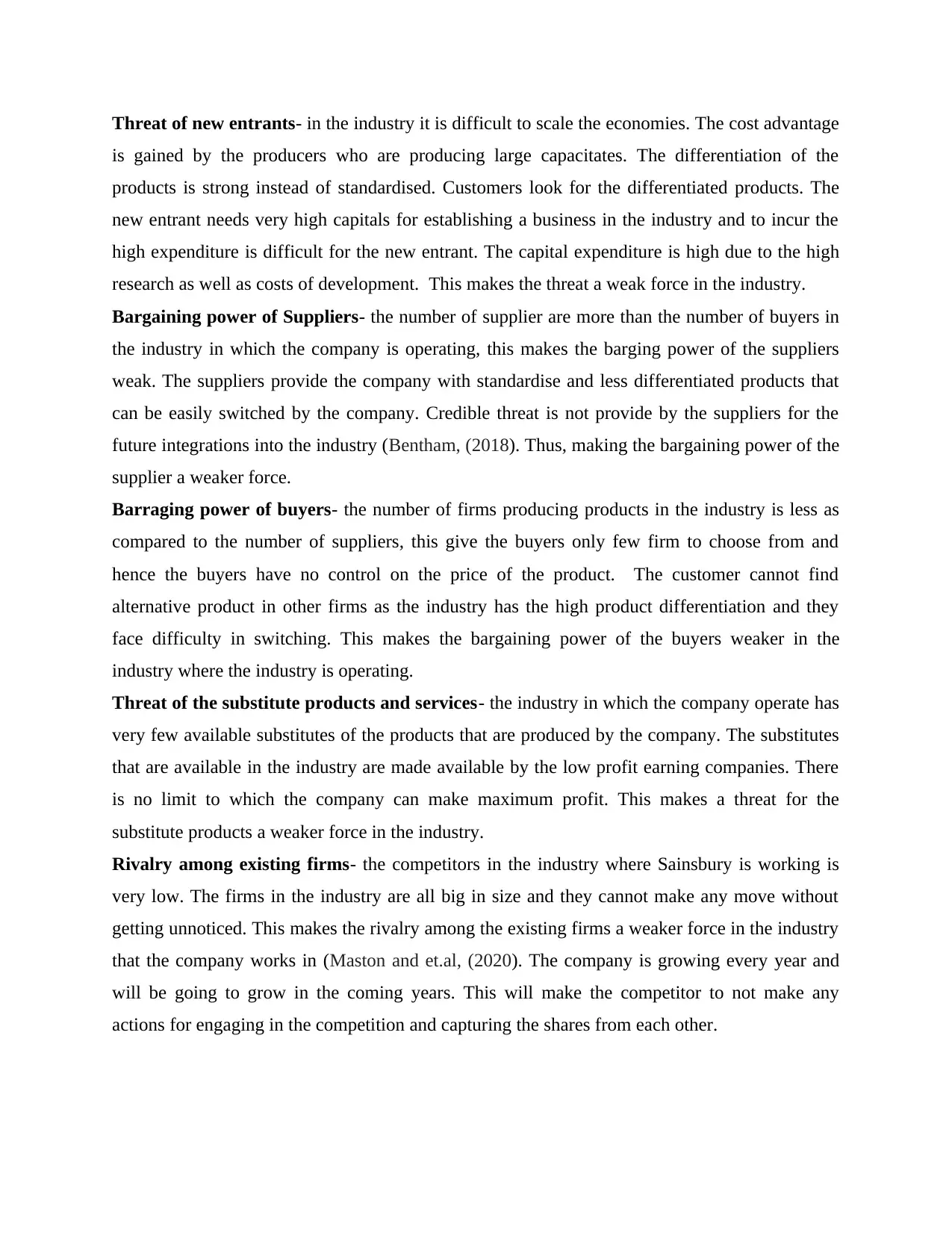
Threat of new entrants- in the industry it is difficult to scale the economies. The cost advantage
is gained by the producers who are producing large capacitates. The differentiation of the
products is strong instead of standardised. Customers look for the differentiated products. The
new entrant needs very high capitals for establishing a business in the industry and to incur the
high expenditure is difficult for the new entrant. The capital expenditure is high due to the high
research as well as costs of development. This makes the threat a weak force in the industry.
Bargaining power of Suppliers- the number of supplier are more than the number of buyers in
the industry in which the company is operating, this makes the barging power of the suppliers
weak. The suppliers provide the company with standardise and less differentiated products that
can be easily switched by the company. Credible threat is not provide by the suppliers for the
future integrations into the industry (Bentham, (2018). Thus, making the bargaining power of the
supplier a weaker force.
Barraging power of buyers- the number of firms producing products in the industry is less as
compared to the number of suppliers, this give the buyers only few firm to choose from and
hence the buyers have no control on the price of the product. The customer cannot find
alternative product in other firms as the industry has the high product differentiation and they
face difficulty in switching. This makes the bargaining power of the buyers weaker in the
industry where the industry is operating.
Threat of the substitute products and services- the industry in which the company operate has
very few available substitutes of the products that are produced by the company. The substitutes
that are available in the industry are made available by the low profit earning companies. There
is no limit to which the company can make maximum profit. This makes a threat for the
substitute products a weaker force in the industry.
Rivalry among existing firms- the competitors in the industry where Sainsbury is working is
very low. The firms in the industry are all big in size and they cannot make any move without
getting unnoticed. This makes the rivalry among the existing firms a weaker force in the industry
that the company works in (Maston and et.al, (2020). The company is growing every year and
will be going to grow in the coming years. This will make the competitor to not make any
actions for engaging in the competition and capturing the shares from each other.
is gained by the producers who are producing large capacitates. The differentiation of the
products is strong instead of standardised. Customers look for the differentiated products. The
new entrant needs very high capitals for establishing a business in the industry and to incur the
high expenditure is difficult for the new entrant. The capital expenditure is high due to the high
research as well as costs of development. This makes the threat a weak force in the industry.
Bargaining power of Suppliers- the number of supplier are more than the number of buyers in
the industry in which the company is operating, this makes the barging power of the suppliers
weak. The suppliers provide the company with standardise and less differentiated products that
can be easily switched by the company. Credible threat is not provide by the suppliers for the
future integrations into the industry (Bentham, (2018). Thus, making the bargaining power of the
supplier a weaker force.
Barraging power of buyers- the number of firms producing products in the industry is less as
compared to the number of suppliers, this give the buyers only few firm to choose from and
hence the buyers have no control on the price of the product. The customer cannot find
alternative product in other firms as the industry has the high product differentiation and they
face difficulty in switching. This makes the bargaining power of the buyers weaker in the
industry where the industry is operating.
Threat of the substitute products and services- the industry in which the company operate has
very few available substitutes of the products that are produced by the company. The substitutes
that are available in the industry are made available by the low profit earning companies. There
is no limit to which the company can make maximum profit. This makes a threat for the
substitute products a weaker force in the industry.
Rivalry among existing firms- the competitors in the industry where Sainsbury is working is
very low. The firms in the industry are all big in size and they cannot make any move without
getting unnoticed. This makes the rivalry among the existing firms a weaker force in the industry
that the company works in (Maston and et.al, (2020). The company is growing every year and
will be going to grow in the coming years. This will make the competitor to not make any
actions for engaging in the competition and capturing the shares from each other.
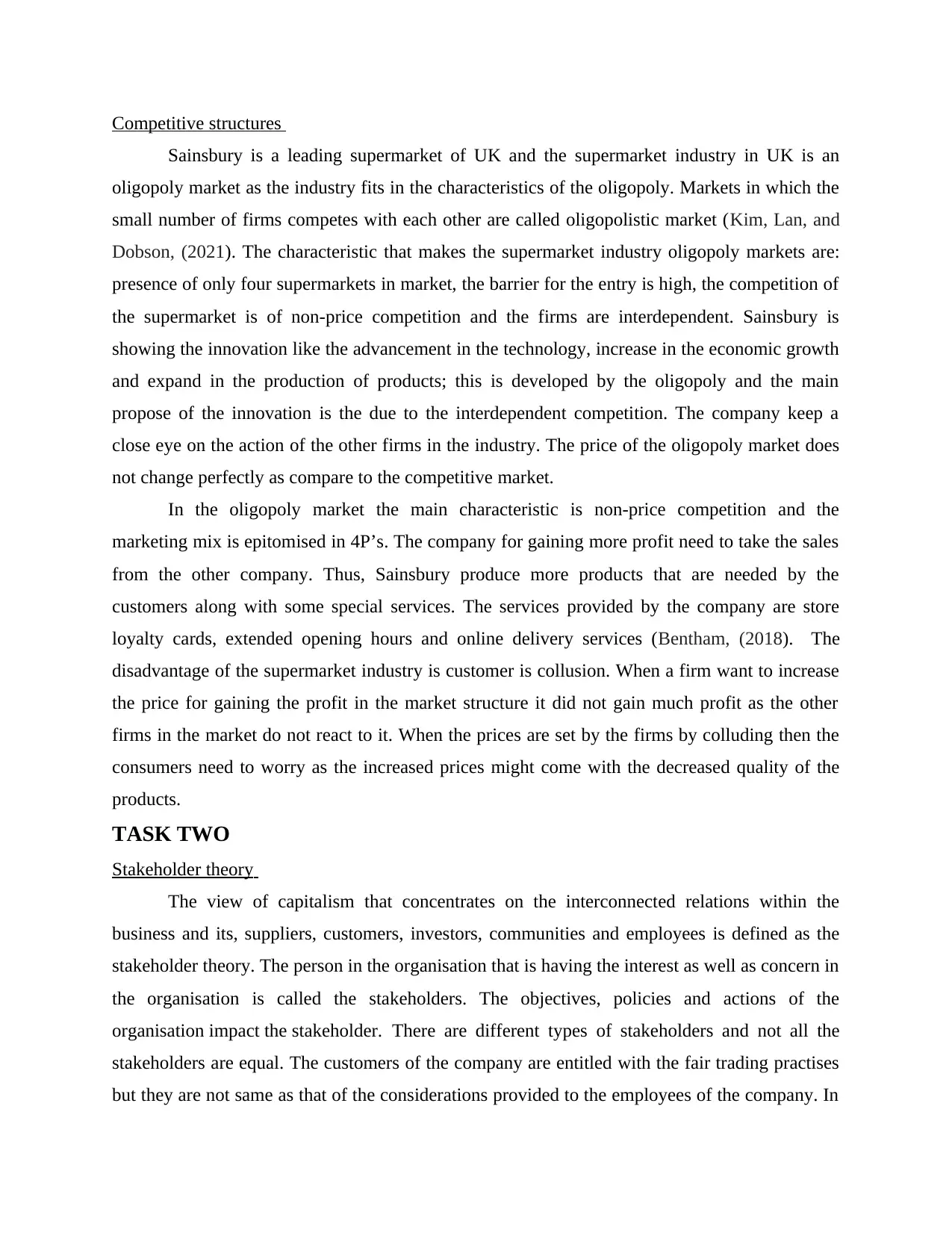
Competitive structures
Sainsbury is a leading supermarket of UK and the supermarket industry in UK is an
oligopoly market as the industry fits in the characteristics of the oligopoly. Markets in which the
small number of firms competes with each other are called oligopolistic market (Kim, Lan, and
Dobson, (2021). The characteristic that makes the supermarket industry oligopoly markets are:
presence of only four supermarkets in market, the barrier for the entry is high, the competition of
the supermarket is of non-price competition and the firms are interdependent. Sainsbury is
showing the innovation like the advancement in the technology, increase in the economic growth
and expand in the production of products; this is developed by the oligopoly and the main
propose of the innovation is the due to the interdependent competition. The company keep a
close eye on the action of the other firms in the industry. The price of the oligopoly market does
not change perfectly as compare to the competitive market.
In the oligopoly market the main characteristic is non-price competition and the
marketing mix is epitomised in 4P’s. The company for gaining more profit need to take the sales
from the other company. Thus, Sainsbury produce more products that are needed by the
customers along with some special services. The services provided by the company are store
loyalty cards, extended opening hours and online delivery services (Bentham, (2018). The
disadvantage of the supermarket industry is customer is collusion. When a firm want to increase
the price for gaining the profit in the market structure it did not gain much profit as the other
firms in the market do not react to it. When the prices are set by the firms by colluding then the
consumers need to worry as the increased prices might come with the decreased quality of the
products.
TASK TWO
Stakeholder theory
The view of capitalism that concentrates on the interconnected relations within the
business and its, suppliers, customers, investors, communities and employees is defined as the
stakeholder theory. The person in the organisation that is having the interest as well as concern in
the organisation is called the stakeholders. The objectives, policies and actions of the
organisation impact the stakeholder. There are different types of stakeholders and not all the
stakeholders are equal. The customers of the company are entitled with the fair trading practises
but they are not same as that of the considerations provided to the employees of the company. In
Sainsbury is a leading supermarket of UK and the supermarket industry in UK is an
oligopoly market as the industry fits in the characteristics of the oligopoly. Markets in which the
small number of firms competes with each other are called oligopolistic market (Kim, Lan, and
Dobson, (2021). The characteristic that makes the supermarket industry oligopoly markets are:
presence of only four supermarkets in market, the barrier for the entry is high, the competition of
the supermarket is of non-price competition and the firms are interdependent. Sainsbury is
showing the innovation like the advancement in the technology, increase in the economic growth
and expand in the production of products; this is developed by the oligopoly and the main
propose of the innovation is the due to the interdependent competition. The company keep a
close eye on the action of the other firms in the industry. The price of the oligopoly market does
not change perfectly as compare to the competitive market.
In the oligopoly market the main characteristic is non-price competition and the
marketing mix is epitomised in 4P’s. The company for gaining more profit need to take the sales
from the other company. Thus, Sainsbury produce more products that are needed by the
customers along with some special services. The services provided by the company are store
loyalty cards, extended opening hours and online delivery services (Bentham, (2018). The
disadvantage of the supermarket industry is customer is collusion. When a firm want to increase
the price for gaining the profit in the market structure it did not gain much profit as the other
firms in the market do not react to it. When the prices are set by the firms by colluding then the
consumers need to worry as the increased prices might come with the decreased quality of the
products.
TASK TWO
Stakeholder theory
The view of capitalism that concentrates on the interconnected relations within the
business and its, suppliers, customers, investors, communities and employees is defined as the
stakeholder theory. The person in the organisation that is having the interest as well as concern in
the organisation is called the stakeholders. The objectives, policies and actions of the
organisation impact the stakeholder. There are different types of stakeholders and not all the
stakeholders are equal. The customers of the company are entitled with the fair trading practises
but they are not same as that of the considerations provided to the employees of the company. In
⊘ This is a preview!⊘
Do you want full access?
Subscribe today to unlock all pages.

Trusted by 1+ million students worldwide
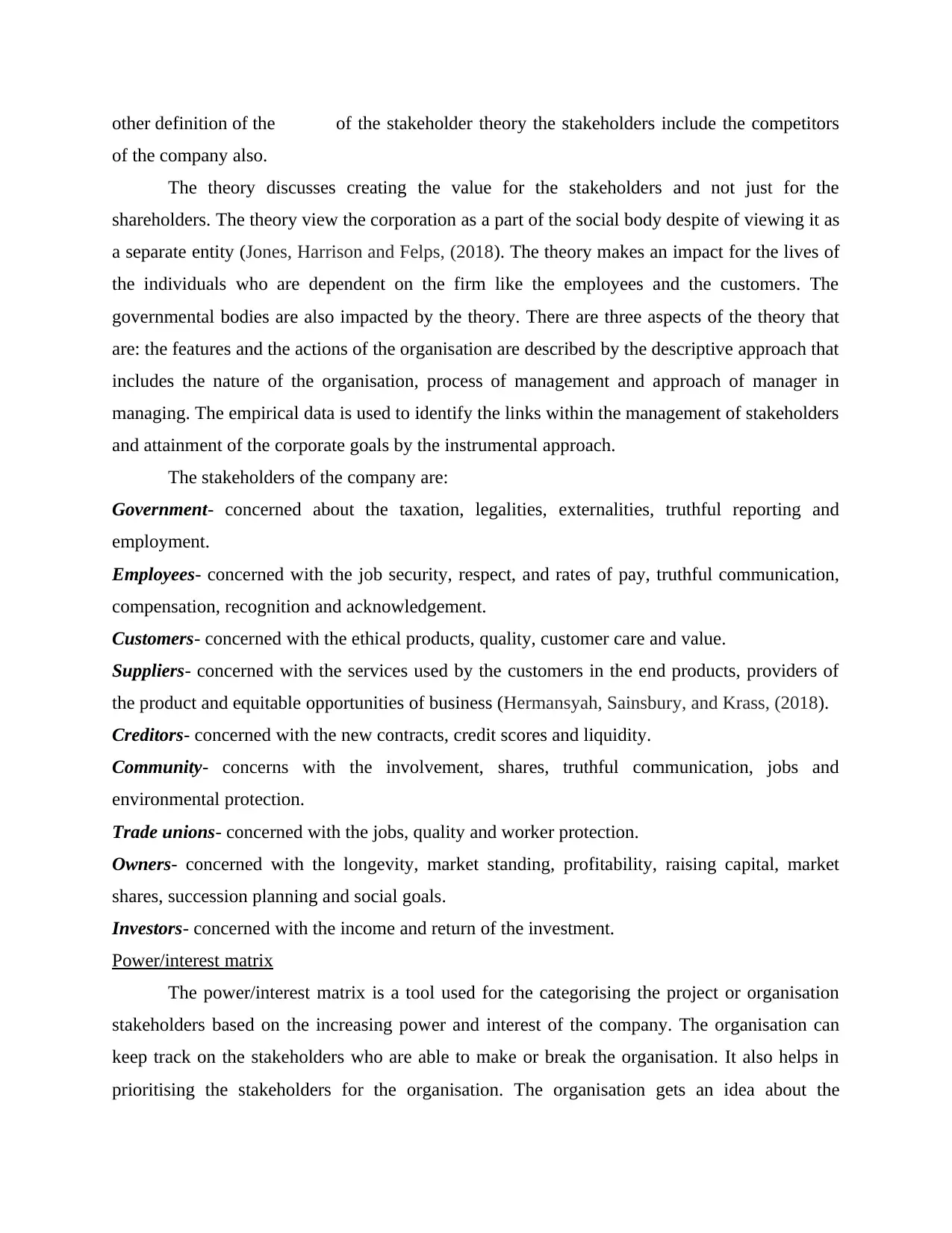
other definition of the of the stakeholder theory the stakeholders include the competitors
of the company also.
The theory discusses creating the value for the stakeholders and not just for the
shareholders. The theory view the corporation as a part of the social body despite of viewing it as
a separate entity (Jones, Harrison and Felps, (2018). The theory makes an impact for the lives of
the individuals who are dependent on the firm like the employees and the customers. The
governmental bodies are also impacted by the theory. There are three aspects of the theory that
are: the features and the actions of the organisation are described by the descriptive approach that
includes the nature of the organisation, process of management and approach of manager in
managing. The empirical data is used to identify the links within the management of stakeholders
and attainment of the corporate goals by the instrumental approach.
The stakeholders of the company are:
Government- concerned about the taxation, legalities, externalities, truthful reporting and
employment.
Employees- concerned with the job security, respect, and rates of pay, truthful communication,
compensation, recognition and acknowledgement.
Customers- concerned with the ethical products, quality, customer care and value.
Suppliers- concerned with the services used by the customers in the end products, providers of
the product and equitable opportunities of business (Hermansyah, Sainsbury, and Krass, (2018).
Creditors- concerned with the new contracts, credit scores and liquidity.
Community- concerns with the involvement, shares, truthful communication, jobs and
environmental protection.
Trade unions- concerned with the jobs, quality and worker protection.
Owners- concerned with the longevity, market standing, profitability, raising capital, market
shares, succession planning and social goals.
Investors- concerned with the income and return of the investment.
Power/interest matrix
The power/interest matrix is a tool used for the categorising the project or organisation
stakeholders based on the increasing power and interest of the company. The organisation can
keep track on the stakeholders who are able to make or break the organisation. It also helps in
prioritising the stakeholders for the organisation. The organisation gets an idea about the
of the company also.
The theory discusses creating the value for the stakeholders and not just for the
shareholders. The theory view the corporation as a part of the social body despite of viewing it as
a separate entity (Jones, Harrison and Felps, (2018). The theory makes an impact for the lives of
the individuals who are dependent on the firm like the employees and the customers. The
governmental bodies are also impacted by the theory. There are three aspects of the theory that
are: the features and the actions of the organisation are described by the descriptive approach that
includes the nature of the organisation, process of management and approach of manager in
managing. The empirical data is used to identify the links within the management of stakeholders
and attainment of the corporate goals by the instrumental approach.
The stakeholders of the company are:
Government- concerned about the taxation, legalities, externalities, truthful reporting and
employment.
Employees- concerned with the job security, respect, and rates of pay, truthful communication,
compensation, recognition and acknowledgement.
Customers- concerned with the ethical products, quality, customer care and value.
Suppliers- concerned with the services used by the customers in the end products, providers of
the product and equitable opportunities of business (Hermansyah, Sainsbury, and Krass, (2018).
Creditors- concerned with the new contracts, credit scores and liquidity.
Community- concerns with the involvement, shares, truthful communication, jobs and
environmental protection.
Trade unions- concerned with the jobs, quality and worker protection.
Owners- concerned with the longevity, market standing, profitability, raising capital, market
shares, succession planning and social goals.
Investors- concerned with the income and return of the investment.
Power/interest matrix
The power/interest matrix is a tool used for the categorising the project or organisation
stakeholders based on the increasing power and interest of the company. The organisation can
keep track on the stakeholders who are able to make or break the organisation. It also helps in
prioritising the stakeholders for the organisation. The organisation gets an idea about the
Paraphrase This Document
Need a fresh take? Get an instant paraphrase of this document with our AI Paraphraser
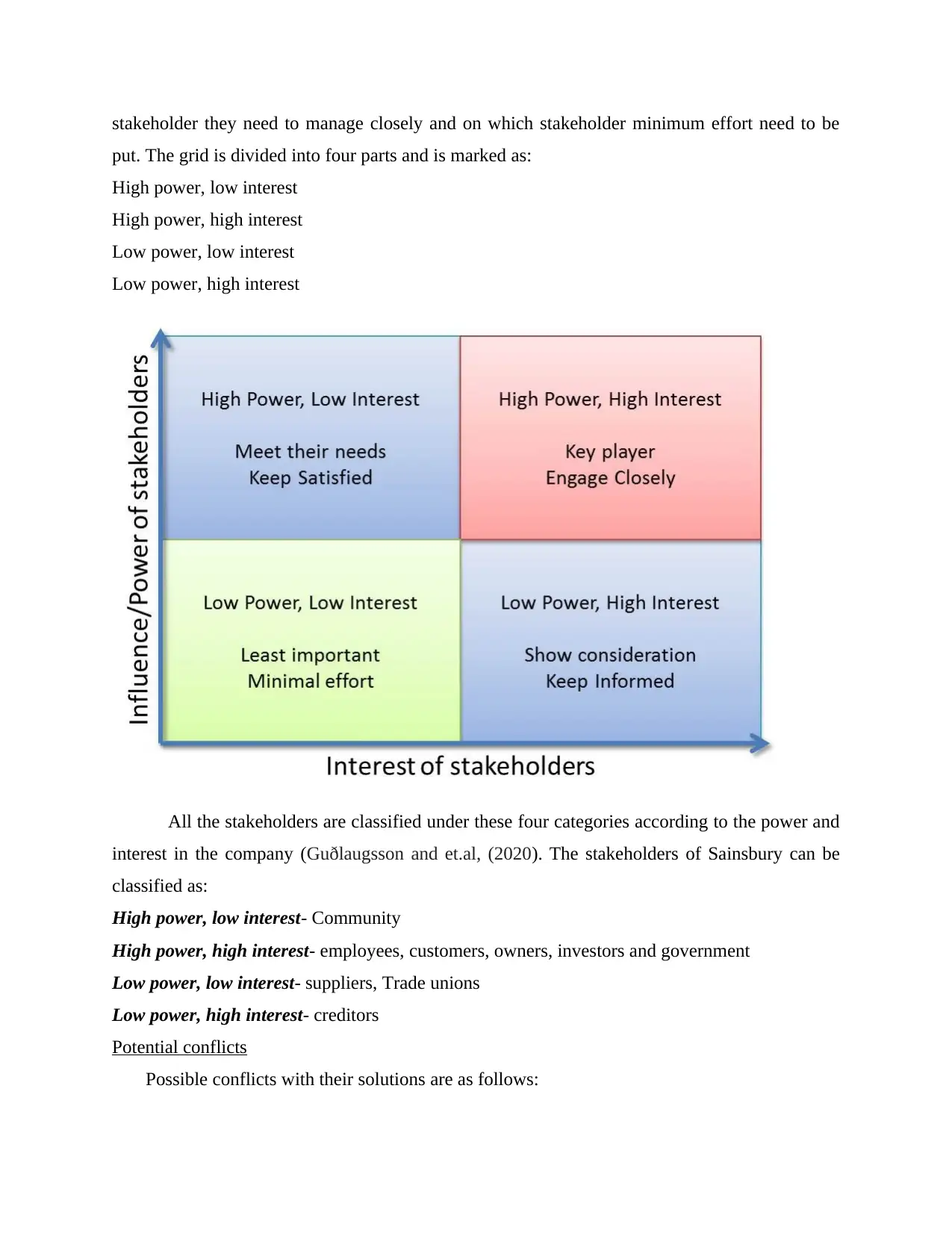
stakeholder they need to manage closely and on which stakeholder minimum effort need to be
put. The grid is divided into four parts and is marked as:
High power, low interest
High power, high interest
Low power, low interest
Low power, high interest
All the stakeholders are classified under these four categories according to the power and
interest in the company (Guðlaugsson and et.al, (2020). The stakeholders of Sainsbury can be
classified as:
High power, low interest- Community
High power, high interest- employees, customers, owners, investors and government
Low power, low interest- suppliers, Trade unions
Low power, high interest- creditors
Potential conflicts
Possible conflicts with their solutions are as follows:
put. The grid is divided into four parts and is marked as:
High power, low interest
High power, high interest
Low power, low interest
Low power, high interest
All the stakeholders are classified under these four categories according to the power and
interest in the company (Guðlaugsson and et.al, (2020). The stakeholders of Sainsbury can be
classified as:
High power, low interest- Community
High power, high interest- employees, customers, owners, investors and government
Low power, low interest- suppliers, Trade unions
Low power, high interest- creditors
Potential conflicts
Possible conflicts with their solutions are as follows:
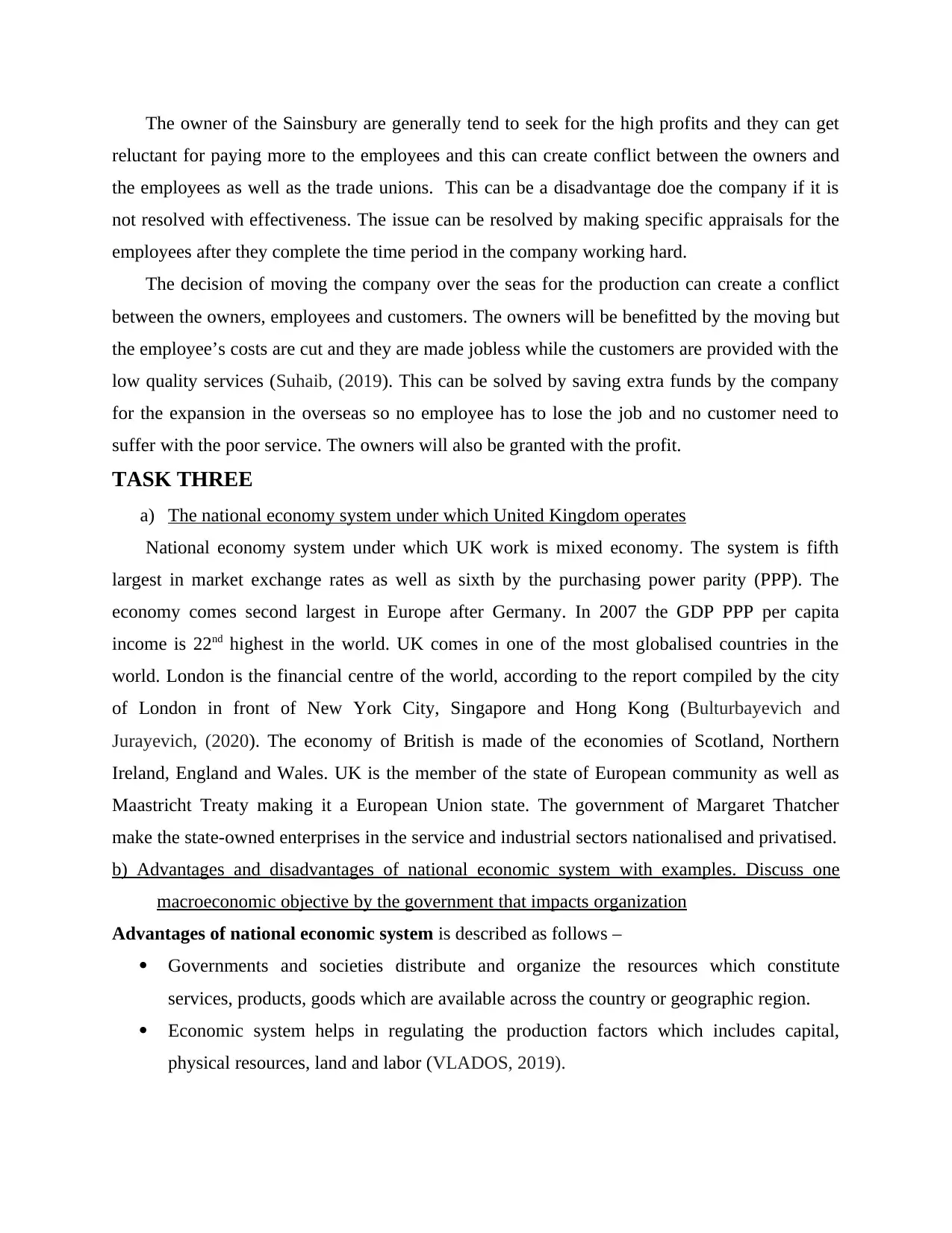
The owner of the Sainsbury are generally tend to seek for the high profits and they can get
reluctant for paying more to the employees and this can create conflict between the owners and
the employees as well as the trade unions. This can be a disadvantage doe the company if it is
not resolved with effectiveness. The issue can be resolved by making specific appraisals for the
employees after they complete the time period in the company working hard.
The decision of moving the company over the seas for the production can create a conflict
between the owners, employees and customers. The owners will be benefitted by the moving but
the employee’s costs are cut and they are made jobless while the customers are provided with the
low quality services (Suhaib, (2019). This can be solved by saving extra funds by the company
for the expansion in the overseas so no employee has to lose the job and no customer need to
suffer with the poor service. The owners will also be granted with the profit.
TASK THREE
a) The national economy system under which United Kingdom operates
National economy system under which UK work is mixed economy. The system is fifth
largest in market exchange rates as well as sixth by the purchasing power parity (PPP). The
economy comes second largest in Europe after Germany. In 2007 the GDP PPP per capita
income is 22nd highest in the world. UK comes in one of the most globalised countries in the
world. London is the financial centre of the world, according to the report compiled by the city
of London in front of New York City, Singapore and Hong Kong (Bulturbayevich and
Jurayevich, (2020). The economy of British is made of the economies of Scotland, Northern
Ireland, England and Wales. UK is the member of the state of European community as well as
Maastricht Treaty making it a European Union state. The government of Margaret Thatcher
make the state-owned enterprises in the service and industrial sectors nationalised and privatised.
b) Advantages and disadvantages of national economic system with examples. Discuss one
macroeconomic objective by the government that impacts organization
Advantages of national economic system is described as follows –
Governments and societies distribute and organize the resources which constitute
services, products, goods which are available across the country or geographic region.
Economic system helps in regulating the production factors which includes capital,
physical resources, land and labor (VLADOS, 2019).
reluctant for paying more to the employees and this can create conflict between the owners and
the employees as well as the trade unions. This can be a disadvantage doe the company if it is
not resolved with effectiveness. The issue can be resolved by making specific appraisals for the
employees after they complete the time period in the company working hard.
The decision of moving the company over the seas for the production can create a conflict
between the owners, employees and customers. The owners will be benefitted by the moving but
the employee’s costs are cut and they are made jobless while the customers are provided with the
low quality services (Suhaib, (2019). This can be solved by saving extra funds by the company
for the expansion in the overseas so no employee has to lose the job and no customer need to
suffer with the poor service. The owners will also be granted with the profit.
TASK THREE
a) The national economy system under which United Kingdom operates
National economy system under which UK work is mixed economy. The system is fifth
largest in market exchange rates as well as sixth by the purchasing power parity (PPP). The
economy comes second largest in Europe after Germany. In 2007 the GDP PPP per capita
income is 22nd highest in the world. UK comes in one of the most globalised countries in the
world. London is the financial centre of the world, according to the report compiled by the city
of London in front of New York City, Singapore and Hong Kong (Bulturbayevich and
Jurayevich, (2020). The economy of British is made of the economies of Scotland, Northern
Ireland, England and Wales. UK is the member of the state of European community as well as
Maastricht Treaty making it a European Union state. The government of Margaret Thatcher
make the state-owned enterprises in the service and industrial sectors nationalised and privatised.
b) Advantages and disadvantages of national economic system with examples. Discuss one
macroeconomic objective by the government that impacts organization
Advantages of national economic system is described as follows –
Governments and societies distribute and organize the resources which constitute
services, products, goods which are available across the country or geographic region.
Economic system helps in regulating the production factors which includes capital,
physical resources, land and labor (VLADOS, 2019).
⊘ This is a preview!⊘
Do you want full access?
Subscribe today to unlock all pages.

Trusted by 1+ million students worldwide
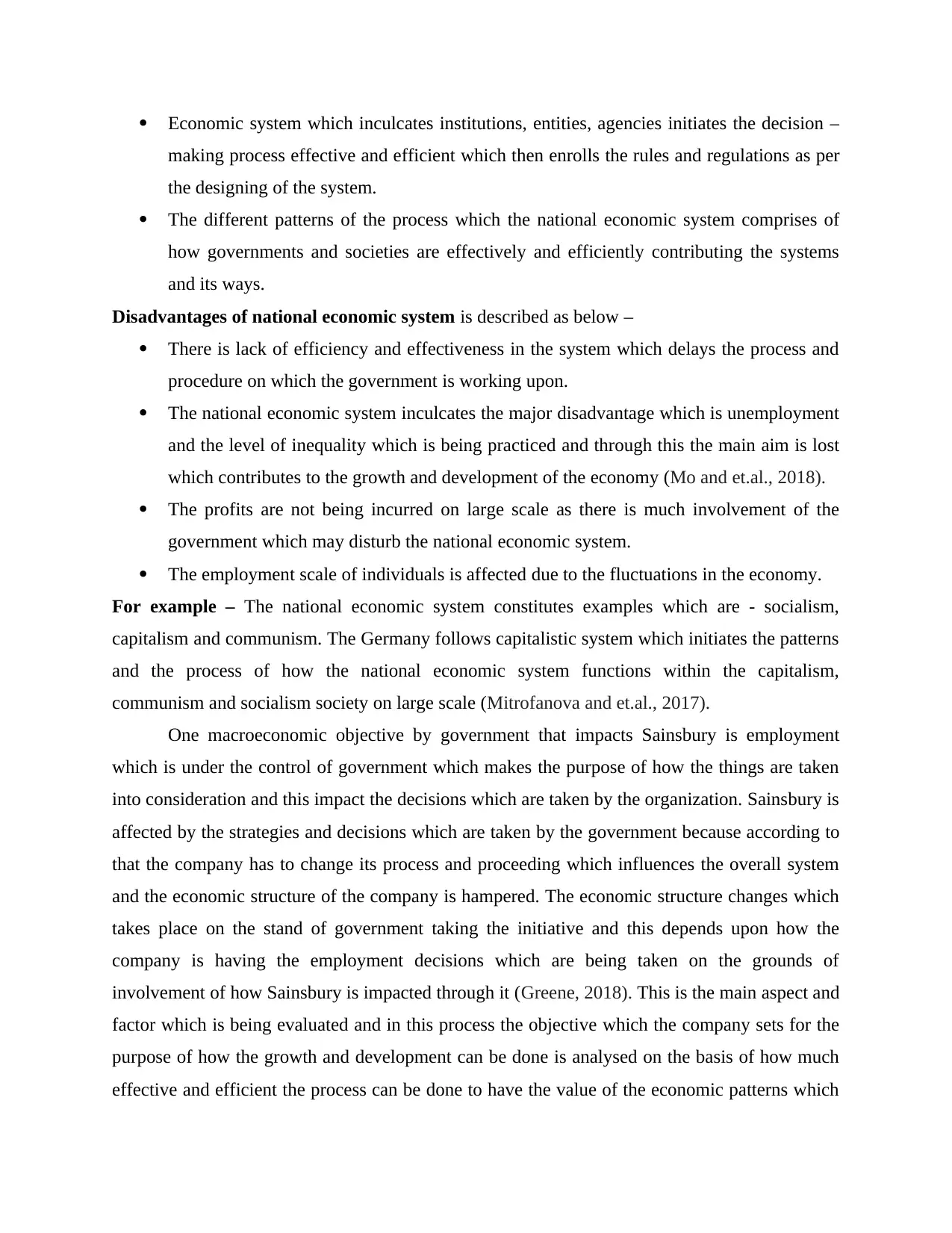
Economic system which inculcates institutions, entities, agencies initiates the decision –
making process effective and efficient which then enrolls the rules and regulations as per
the designing of the system.
The different patterns of the process which the national economic system comprises of
how governments and societies are effectively and efficiently contributing the systems
and its ways.
Disadvantages of national economic system is described as below –
There is lack of efficiency and effectiveness in the system which delays the process and
procedure on which the government is working upon.
The national economic system inculcates the major disadvantage which is unemployment
and the level of inequality which is being practiced and through this the main aim is lost
which contributes to the growth and development of the economy (Mo and et.al., 2018).
The profits are not being incurred on large scale as there is much involvement of the
government which may disturb the national economic system.
The employment scale of individuals is affected due to the fluctuations in the economy.
For example – The national economic system constitutes examples which are - socialism,
capitalism and communism. The Germany follows capitalistic system which initiates the patterns
and the process of how the national economic system functions within the capitalism,
communism and socialism society on large scale (Mitrofanova and et.al., 2017).
One macroeconomic objective by government that impacts Sainsbury is employment
which is under the control of government which makes the purpose of how the things are taken
into consideration and this impact the decisions which are taken by the organization. Sainsbury is
affected by the strategies and decisions which are taken by the government because according to
that the company has to change its process and proceeding which influences the overall system
and the economic structure of the company is hampered. The economic structure changes which
takes place on the stand of government taking the initiative and this depends upon how the
company is having the employment decisions which are being taken on the grounds of
involvement of how Sainsbury is impacted through it (Greene, 2018). This is the main aspect and
factor which is being evaluated and in this process the objective which the company sets for the
purpose of how the growth and development can be done is analysed on the basis of how much
effective and efficient the process can be done to have the value of the economic patterns which
making process effective and efficient which then enrolls the rules and regulations as per
the designing of the system.
The different patterns of the process which the national economic system comprises of
how governments and societies are effectively and efficiently contributing the systems
and its ways.
Disadvantages of national economic system is described as below –
There is lack of efficiency and effectiveness in the system which delays the process and
procedure on which the government is working upon.
The national economic system inculcates the major disadvantage which is unemployment
and the level of inequality which is being practiced and through this the main aim is lost
which contributes to the growth and development of the economy (Mo and et.al., 2018).
The profits are not being incurred on large scale as there is much involvement of the
government which may disturb the national economic system.
The employment scale of individuals is affected due to the fluctuations in the economy.
For example – The national economic system constitutes examples which are - socialism,
capitalism and communism. The Germany follows capitalistic system which initiates the patterns
and the process of how the national economic system functions within the capitalism,
communism and socialism society on large scale (Mitrofanova and et.al., 2017).
One macroeconomic objective by government that impacts Sainsbury is employment
which is under the control of government which makes the purpose of how the things are taken
into consideration and this impact the decisions which are taken by the organization. Sainsbury is
affected by the strategies and decisions which are taken by the government because according to
that the company has to change its process and proceeding which influences the overall system
and the economic structure of the company is hampered. The economic structure changes which
takes place on the stand of government taking the initiative and this depends upon how the
company is having the employment decisions which are being taken on the grounds of
involvement of how Sainsbury is impacted through it (Greene, 2018). This is the main aspect and
factor which is being evaluated and in this process the objective which the company sets for the
purpose of how the growth and development can be done is analysed on the basis of how much
effective and efficient the process can be done to have the value of the economic patterns which
Paraphrase This Document
Need a fresh take? Get an instant paraphrase of this document with our AI Paraphraser
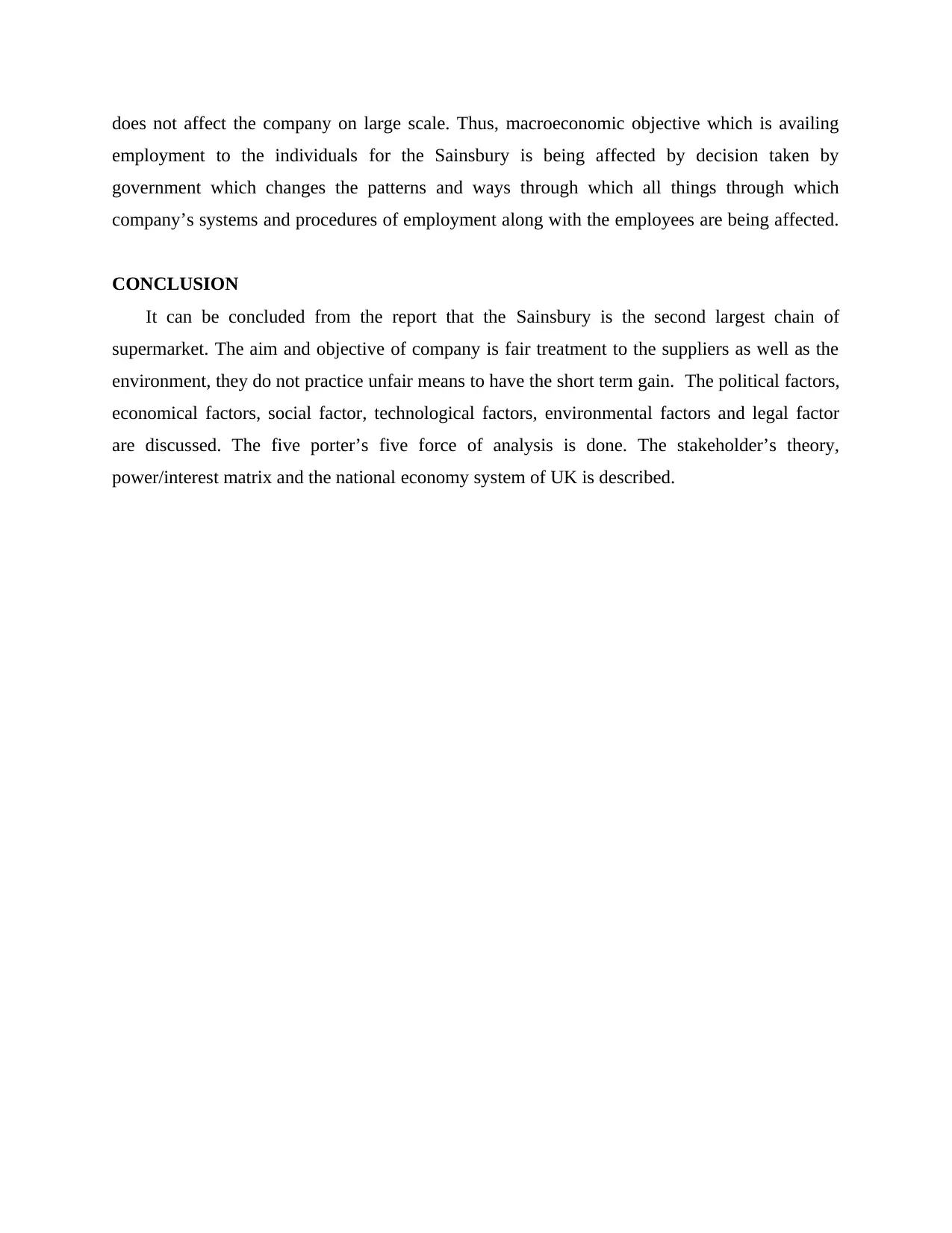
does not affect the company on large scale. Thus, macroeconomic objective which is availing
employment to the individuals for the Sainsbury is being affected by decision taken by
government which changes the patterns and ways through which all things through which
company’s systems and procedures of employment along with the employees are being affected.
CONCLUSION
It can be concluded from the report that the Sainsbury is the second largest chain of
supermarket. The aim and objective of company is fair treatment to the suppliers as well as the
environment, they do not practice unfair means to have the short term gain. The political factors,
economical factors, social factor, technological factors, environmental factors and legal factor
are discussed. The five porter’s five force of analysis is done. The stakeholder’s theory,
power/interest matrix and the national economy system of UK is described.
employment to the individuals for the Sainsbury is being affected by decision taken by
government which changes the patterns and ways through which all things through which
company’s systems and procedures of employment along with the employees are being affected.
CONCLUSION
It can be concluded from the report that the Sainsbury is the second largest chain of
supermarket. The aim and objective of company is fair treatment to the suppliers as well as the
environment, they do not practice unfair means to have the short term gain. The political factors,
economical factors, social factor, technological factors, environmental factors and legal factor
are discussed. The five porter’s five force of analysis is done. The stakeholder’s theory,
power/interest matrix and the national economy system of UK is described.
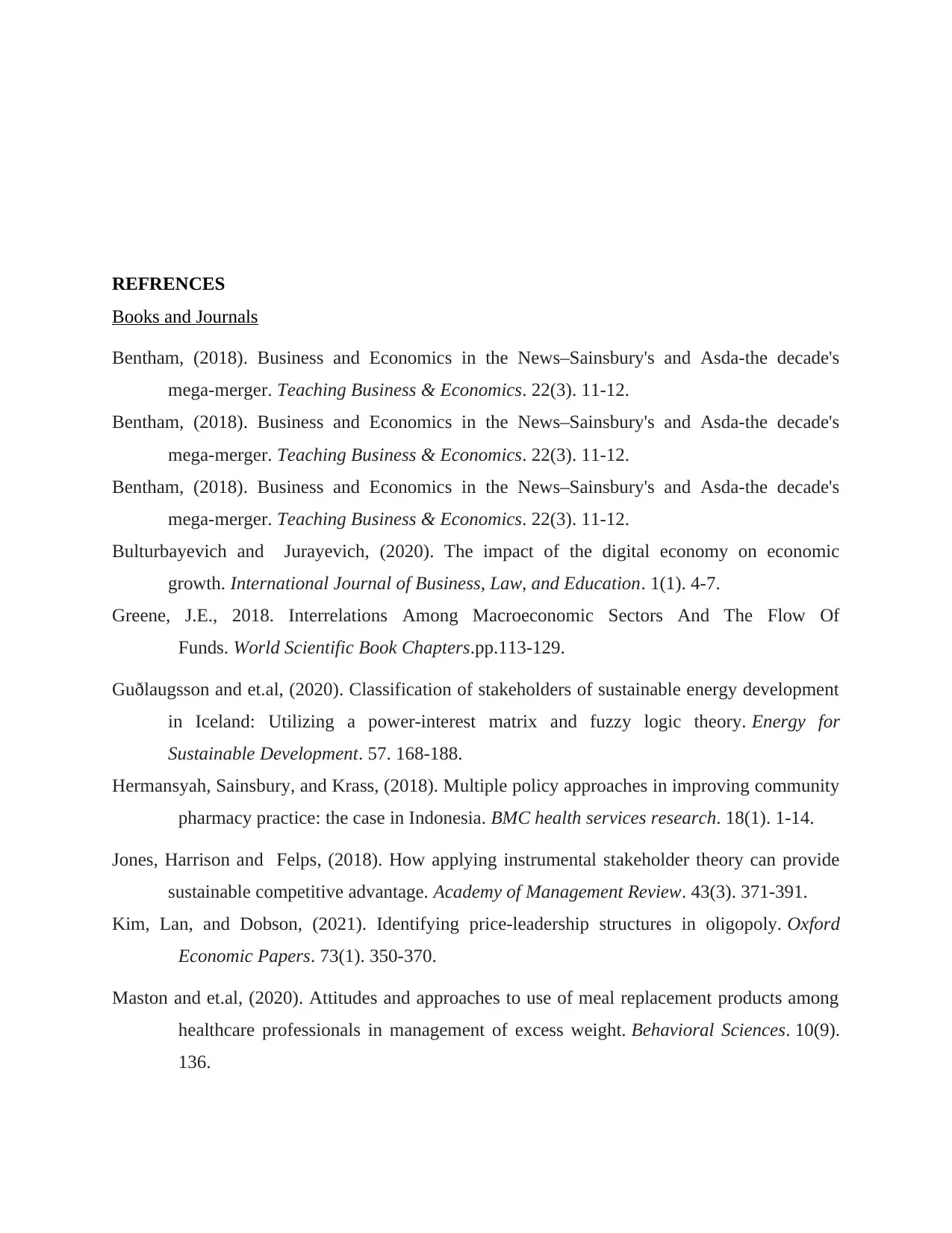
REFRENCES
Books and Journals
Bentham, (2018). Business and Economics in the News–Sainsbury's and Asda-the decade's
mega-merger. Teaching Business & Economics. 22(3). 11-12.
Bentham, (2018). Business and Economics in the News–Sainsbury's and Asda-the decade's
mega-merger. Teaching Business & Economics. 22(3). 11-12.
Bentham, (2018). Business and Economics in the News–Sainsbury's and Asda-the decade's
mega-merger. Teaching Business & Economics. 22(3). 11-12.
Bulturbayevich and Jurayevich, (2020). The impact of the digital economy on economic
growth. International Journal of Business, Law, and Education. 1(1). 4-7.
Greene, J.E., 2018. Interrelations Among Macroeconomic Sectors And The Flow Of
Funds. World Scientific Book Chapters.pp.113-129.
Guðlaugsson and et.al, (2020). Classification of stakeholders of sustainable energy development
in Iceland: Utilizing a power-interest matrix and fuzzy logic theory. Energy for
Sustainable Development. 57. 168-188.
Hermansyah, Sainsbury, and Krass, (2018). Multiple policy approaches in improving community
pharmacy practice: the case in Indonesia. BMC health services research. 18(1). 1-14.
Jones, Harrison and Felps, (2018). How applying instrumental stakeholder theory can provide
sustainable competitive advantage. Academy of Management Review. 43(3). 371-391.
Kim, Lan, and Dobson, (2021). Identifying price-leadership structures in oligopoly. Oxford
Economic Papers. 73(1). 350-370.
Maston and et.al, (2020). Attitudes and approaches to use of meal replacement products among
healthcare professionals in management of excess weight. Behavioral Sciences. 10(9).
136.
Books and Journals
Bentham, (2018). Business and Economics in the News–Sainsbury's and Asda-the decade's
mega-merger. Teaching Business & Economics. 22(3). 11-12.
Bentham, (2018). Business and Economics in the News–Sainsbury's and Asda-the decade's
mega-merger. Teaching Business & Economics. 22(3). 11-12.
Bentham, (2018). Business and Economics in the News–Sainsbury's and Asda-the decade's
mega-merger. Teaching Business & Economics. 22(3). 11-12.
Bulturbayevich and Jurayevich, (2020). The impact of the digital economy on economic
growth. International Journal of Business, Law, and Education. 1(1). 4-7.
Greene, J.E., 2018. Interrelations Among Macroeconomic Sectors And The Flow Of
Funds. World Scientific Book Chapters.pp.113-129.
Guðlaugsson and et.al, (2020). Classification of stakeholders of sustainable energy development
in Iceland: Utilizing a power-interest matrix and fuzzy logic theory. Energy for
Sustainable Development. 57. 168-188.
Hermansyah, Sainsbury, and Krass, (2018). Multiple policy approaches in improving community
pharmacy practice: the case in Indonesia. BMC health services research. 18(1). 1-14.
Jones, Harrison and Felps, (2018). How applying instrumental stakeholder theory can provide
sustainable competitive advantage. Academy of Management Review. 43(3). 371-391.
Kim, Lan, and Dobson, (2021). Identifying price-leadership structures in oligopoly. Oxford
Economic Papers. 73(1). 350-370.
Maston and et.al, (2020). Attitudes and approaches to use of meal replacement products among
healthcare professionals in management of excess weight. Behavioral Sciences. 10(9).
136.
⊘ This is a preview!⊘
Do you want full access?
Subscribe today to unlock all pages.

Trusted by 1+ million students worldwide
1 out of 13
Related Documents
Your All-in-One AI-Powered Toolkit for Academic Success.
+13062052269
info@desklib.com
Available 24*7 on WhatsApp / Email
![[object Object]](/_next/static/media/star-bottom.7253800d.svg)
Unlock your academic potential
Copyright © 2020–2025 A2Z Services. All Rights Reserved. Developed and managed by ZUCOL.





